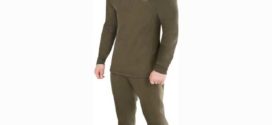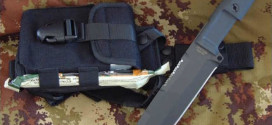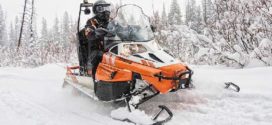Previously, the problem of orientation in the forest or on the water was not so acute, since there was plenty of everything near the settlements - birds, game, fish. Now, in order to return home with prey, hunters and amateur fishermen have to drive off as far as possible, that is, to “fish” in unfamiliar terrain.
Therefore, to argue that a navigator for hunting or fishing is nothing more than a luxury, a kind of tribute to fashion, can only be a person, either completely far from such a way of spending time, or one who is content with a couple of minnows caught in a nearby reservoir. This article will tell the reader how the GPS devices for fishing and hunting differ from the usual analogues used in vehicles, and what to look for when buying a particular model.
Content
Requirements for navigators for hunters and fishermen
Taking into account the peculiarities of operation, they are understandable, but it would be useful to recall.
- Increased protection of the “stuffing” from moisture and dust.
- Mobility, that is, the ability to work autonomously for a long time.
- Light weight.
- Miniature.
- Multifunctionality. As a rule, most hunters are also avid anglers. Consequently, the conditions under which they have to fish can be very different. That is why it is advisable to purchase a navigator with a large number of options.
Navigator Selection Criteria
The capabilities of the "receiver"
- Signals to the instrument come from many satellites in orbit. How many of them can a specific navigator “work” with?
- Sensitivity. Not all devices that maintain stable communication in open areas also function reliably in the forest. This is one of the reasons why navigators installed in cars, when fishing or hunting, are usually useless.
Display options
- Resolution. The clarity of the image directly depends on this.
- Navigator screen size. There is nothing to comment on here.
When deciding on a display, you need to take into account the peculiarities of your vision and prepare for the worst situation (the golden rule, which many people forget). For example, there are no glasses at hand, the sun is on the horizon or has already gone. Will it be possible to see anything on the navigator screen? And not just vague outlines of the contours, but to see a completely clear picture, a diagram.
But the color display or black and white is up to the user to decide. For orientation in the area while fishing or hunting, this does not matter. A color screen is needed only if the navigator has special options for viewing, for example, downloaded files in order to pass the time. How relevant is this for a person who has ventured into nature with a very specific purpose?
It is unlikely that anyone will exchange an evening by the fire for a film that can be seen at home on the TV screen. And given that the cost of a "color" navigator is much higher, it is unlikely that such a device is needed for hunting or fishing.
Duration of continuous work
This refers to how often the batteries need to be replaced. It depends on how much battery you need to take with you.
Having a memory card
Navigators without this service, which determine only the geographical coordinates of the standing point, will not let you get lost. But only on condition that a person has a compass, a map of the area with him and is trained to work with them. For example, it is correct to make a “binding”, determine the sides of the horizon, and so on. Therefore, when choosing a model, you should pay attention not only to the ability to load information into the navigator (memory capacity), but also to the presence of a built-in magnetic pointer.
All of the above are just general guidelines. Manufacturers are constantly updating, implementing, and improving something, so it is unrealistic to cover all the nuances of the functioning of navigators. For example, is it possible to mount a separate device on a dog's collar (for hunters).
Anglers may prefer a stationary model that is mounted on a boat or boat. Some navigators have a sonar function . For someone who goes to nature not just to sit with a fishing rod, but to return with a rich catch, this is an indispensable help. But the hunter does not need this option at all. But if there is a built-in barometer, it will be equally useful for everyone who is forced to navigate the weather conditions. The same applies to multi-level screen backlighting.
And yet - what specific navigator should a hunter or fisherman choose for himself?
Not all the advantages of devices that manufacturers and sellers focus on the buyer's attention are tested in practice. Some functions are in fact useless, others do not live up to expectations.
- Before going to the store, it makes sense to interview friends who already use navigators. Their opinion, reviews of models are more objective.
- You can learn a lot of useful things by “visiting” thematic forums. On them, fishermen and hunters frankly talk about the problems that they encounter when using GPS devices in the field.
The author did just that. It turned out that navigators under the GARMIN brand are the most popular among the "average" lovers of hunting and fishing. Firstly, the devices are available in various modifications, therefore, you can choose the most suitable series. Secondly, simple functionality, so it’s easy to deal with the features of the navigator even for a person who is still on “you” with modern electronics. Thirdly, the price of products is quite democratic, and their purchase is not burdensome for the family budget.
"E-Trex" 10 series
The device is sold in a yellow-black case that meets all the requirements for moisture protection and shock resistance. Screen size 43 x 36 black and white; simple menu; continuous work during the day. The memory allows you to save information about 1000 standing points on 50 different routes.
The price is within 5,500 rubles.
The same device of the 20th series is able to work not only in the GPS system, but also in the domestic Glonass. 1.7 GB memory, color screen, 2000 saved routes and marked waypoints. All this increases the cost of the device.
The price is about 9,800 rubles.
"Montana", model 650T
A 4-inch color display, a 5-megapixel camera, a 16-hour battery, the ability to install additional batteries and expand the memory, dual screen orientation and a number of other features - this significantly increases the cost of such a navigator. And to buy or not, it's up to you, the reader.
The price is within 18,900 rubles.
The range of navigators under these and other brands is not limited to the listed models. But, at least, it is already clear what to look for when choosing a device and what approximate prices for similar products for hunters and fishermen are found at points of sale.
Hello, I am Alexander, the mastermind behind the blog.
In terms of career and free time, I connected my life with the forest. How else, when you live in Karelia! In this blog, I am responsible for the hunting, hiking and equipment sections. Welcome to my world!
 Survival Lessons Tips for the survivalist, fisherman and hunter
Survival Lessons Tips for the survivalist, fisherman and hunter





